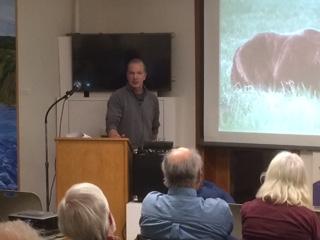Striking a balance that provides ample living space for both humans and wild animals isn’t always easy. A biologist with the Department of Fish and Game talked with Homer residents about the methods wildlife managers use to keep the peace between people and brown bears.
Brown bears are considered a valuable natural resource on the Peninsula. People come from around the world to hunt and view them. But it’s well known that allowing too many bears near human populations is asking for trouble.

PHOTO BY QUINTON CHANDLER/KBBI
The Pratt Museum asked Kenai Peninsula area management biologist Jeff Sellenger to discuss how the Department of Fish and Game’s management practices as part of the museum’s new bear exhibit.
Sellenger says Fish and Game aims for a happy medium when managing the bear population.
“We want to always maintain healthy populations but we can go anywhere from the bottom level of that to not harvesting any animals and just kind of letting them do what they’re going to do. That’s the range we have to manage,” said Sellenger.
Sellenger says peninsula residents’ opinions are especially important because the Board of Game depends on the public to help them decide if the bear population should go up or down.
“There’s a lot of people out there who think bears should go down even further and then there are people who think there should be more bears. We’re in that range somewhere [but] exactly where that line is…. I’m not positive,” said Sellenger.
Fish and Game operates around strict management objectives, set by the Board of Game, for each wildlife population they oversee. This year’s management objectives for brown bears are:
“As far as hunting goes [it’s] to not exceed 50-60 total, or 8 to 12 adult female – human caused – mortalities during calendar year 2015,” said Sellenger. “Also to maintain a healthy viable population of brown bears for multiple uses [and] to reduce the brown bear population around communities to minimize human-bear conflicts.
Sellenger says human-bear conflicts are down because the population has been reduced in the past few years by more liberal hunting regulations. Right now he says Fish and Game is focusing on keeping bear populations near communities at their current level.
“I think people are more satisfied that what they were maybe five years ago. We get a lot fewer complaints out of the Soldotna office regarding negative bear-human encounters,” said Sellenger.
Sellenger says he doesn’t need to know the actual number of brown bears to do his job.
“We can learn from complaints, sightings, DLPs, we use a lot of anecdotal information to determine where we are,” said Sellenger.
DLPs are wildlife kills in ‘defense of life or property.’ Sellenger says combining that anecdotal information and data collected through careful research is part of the art of being a manager.
“Ideally we would know the exact number. We’d know the number of reproductive sows. We’d know every little bit of reproduction that occurs, the survivorship rates of every different age class of bears. In a perfect world you would have that, but we’re far from that. We’ve got to work with what we can get,” said Sellenger.
According to Sellenger’s presentation, 70 brown bears were killed by hunters in 2013. That’s more bears than any year since 1961. But the number of bears killed outside of hunts fell by a lot in the last few years resulting in fewer than 10 deaths this year and last year as well.
Sellenger attributes those numbers to liberalized hunting regulations and he adds that more people are learning how to minimize the number of bear attractants in and around their homes.
Quinton Chandler is a reporter at KTOO in Juneau.




